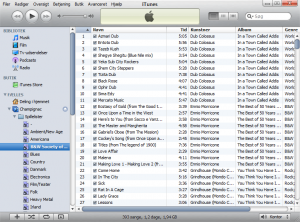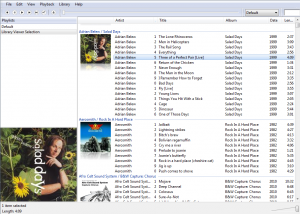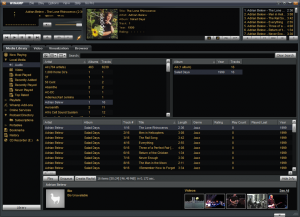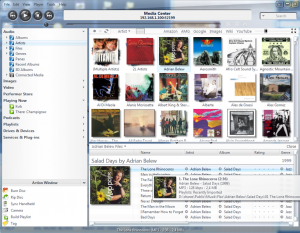 Chris Connaker of Computer Audiophile just published an extremely interesting article on ripping Blue-ray audio discs for streaming on HD capable players. Mildly put the task of ripping HD audio has hitherto been a daunting one and rarely successful. German MSM Studios have conjured up a method that involves special software on the disc allowing networked Blue-ray players or computer based drives to copy the tracks off the disc in HD. But ‘nuff paraphrasing. Get yourself over to Computer Audiophile and have the best read so far this year…
Chris Connaker of Computer Audiophile just published an extremely interesting article on ripping Blue-ray audio discs for streaming on HD capable players. Mildly put the task of ripping HD audio has hitherto been a daunting one and rarely successful. German MSM Studios have conjured up a method that involves special software on the disc allowing networked Blue-ray players or computer based drives to copy the tracks off the disc in HD. But ‘nuff paraphrasing. Get yourself over to Computer Audiophile and have the best read so far this year…
media|STREAMERS
The market for media hubs is difficult to navigate – I try to chart some waters here
Category Archives: Flac
High Resolution Blu-ray The Easy Way
Olive O6HD
![]()
![]()
![]()
![]()
![]()
![]()
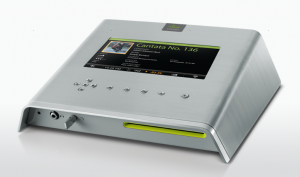 Olive has been on the media streamer market for the better part of the market’s existence, yet hasn’t made much noise. Their latest initiative could be here to change that: The world’s first HD Audiophile Server. That is what they call it and looking at the specs, it’s definitely the world’s first something, even if others have touched on this before. The Linn DS is definitely up there (with a slightly more rabid price tag) and so is the NaimUniti Serve. The latter being a really attractive setup in its family configuration of server, players and mini players.
Olive has been on the media streamer market for the better part of the market’s existence, yet hasn’t made much noise. Their latest initiative could be here to change that: The world’s first HD Audiophile Server. That is what they call it and looking at the specs, it’s definitely the world’s first something, even if others have touched on this before. The Linn DS is definitely up there (with a slightly more rabid price tag) and so is the NaimUniti Serve. The latter being a really attractive setup in its family configuration of server, players and mini players.
The device itself is cool if not exactly novel. The design is like other Olives, slightly unusual and definitely not very shelf-friendly. The slanted cabinet has a touch screen on top and a handful of heavy duty connectors on the back. The front has a slot for ripping CDs. To get you going, the O6HD comes pre-installed with 12 HD tracks from Chesky records. Hand-built in America and all, it will look good on a serving table or something.
The power supply is split into two, to feed analog and digital circuits with each their own chill filtered juice. The DACs are 24-bit Burr-Brown PCM1792 supporting high resolution conversion of 24-bit/192KHz. It comes with 2TB of storage, letting you rip quite a bit of CDs, at least in 16-bit resolution. At full resolution it is not one byte too much. Unfortunately the CD transport is just that. A CD drive. It doesn’t support DVD or SACD so the only option for actually getting any HD content is to rip it elsewhere or download HD tracks.
A rather cool feature is genre specific tags. Only information pertaining to the specific type of music is shown in the genre navigation. That is really good news for classical music connoisseurs. Add to that a bit of color coding and a bloody nice glass touch screen, and you have a pretty nifty dashboard. The ever present iPhone / iPod Touch remote isn’t missing either.
Software rundown–part 2
In an earlier article, I had a quick run through of 4 media player applications. Apple iTunes, Foobar2000, WinAmp and J. River Media Center. This time I will go another set of players; a triplet that are not that much unlike the previous batch – at least not on the surface.
This week’s selection are: Microsoft Zune, Clementine and Logitech SqueezePlay.
Microsoft Zune
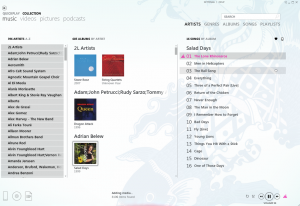 Microsoft Zune is not only a portable MP3 player. It is also the name of a piece of companion software specifically made for said player. It is, however, a quite capable software player in it’s own right.
Microsoft Zune is not only a portable MP3 player. It is also the name of a piece of companion software specifically made for said player. It is, however, a quite capable software player in it’s own right.
Installing it can be a bit of a challenge. If the version downloadable from the official home page will not install, try and download the complete package from Microsoft’s download center – download.microsoft.com. It is quite large but less prone to installation hick-ups. Unlike most of its cousins, Zune comes in both 32 bit and 64 bit versions, letting you take advantage of those RAM blocks above 4GB on your 64 bit Windows. Not sure that it makes much difference with this particular piece of software, though, but there you are.
Zune sports a minimalistic and classy user interface. Everything scrolls smoothly and has a high-key prettiness not often seen. Surely not your average Microsoft application look. On the UX side of things, this is not always a good thing – in fact, Zune is exactly as unintuitive as the majority of media players out there. Barebones and adequate. Not much more to say about this one, except for one thing: It doesn’t support Flac.
3 out of 5 for slick operation but few supported formats and no multi room.
![]()
Clementine
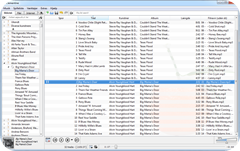 Amarok is a renowned media player for Linux and the antecessor of Clementine. It cannot deny its roots but at the same time it is curiously sleek and sports a fluent navigation many players could learn from. If you want a snappy interface that reacts promptly to your every command and a UI with no bells or whistles whatsoever, this one is for you. Add to that a thriving community and a promising future is ahead. It doesn’t do much in terms of remote control or multi room playing – but when it comes down to it, not many do. Needless to say, Clementine plays both Flac and Ogg Vorbis.
Amarok is a renowned media player for Linux and the antecessor of Clementine. It cannot deny its roots but at the same time it is curiously sleek and sports a fluent navigation many players could learn from. If you want a snappy interface that reacts promptly to your every command and a UI with no bells or whistles whatsoever, this one is for you. Add to that a thriving community and a promising future is ahead. It doesn’t do much in terms of remote control or multi room playing – but when it comes down to it, not many do. Needless to say, Clementine plays both Flac and Ogg Vorbis.
3 out of 5 for uncomplicated and slick operation but no multi room.
![]()
Logitech SqueezePlay
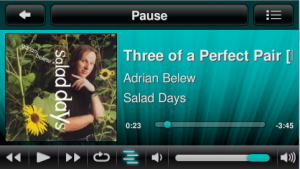 SqueezePlay is a PC version of Logitech’s (formerly Slimdevices) SqueezeBox media streamer family. The software version of the player ties seamlessly into the SqueezeBox universe and the SqueezeBox Server. The latter is responsible for managing your music library and streaming to your devices. The wonderful part about SqueezePlay is not its tidy UI or abundant features but the fact that it can remote control other SqueezePlay’ers as well as any SqueezeBox you may have on your network.
SqueezePlay is a PC version of Logitech’s (formerly Slimdevices) SqueezeBox media streamer family. The software version of the player ties seamlessly into the SqueezeBox universe and the SqueezeBox Server. The latter is responsible for managing your music library and streaming to your devices. The wonderful part about SqueezePlay is not its tidy UI or abundant features but the fact that it can remote control other SqueezePlay’ers as well as any SqueezeBox you may have on your network.
If you don’t already own a Squeezebox thingy, installing this piece of software makes it very difficult not to want a Duet or a Transporter too. Previously the server (once known as SqueezeCenter) was overly complicated to set up and operate. This is all history. The server UI is clean and to the point. If you want to tweak advanced settings, you can get to them through little inconspicuous dropdown boxes – and quite frankly; you shouldn’t need to. There are some pretty nifty things hidden in the advanced settings, though. Among other things, you can make the server transcode certain file formats to save bandwidth or improve compatibility.
Sonos could learn a bit from Logitech here. Sonos have a desktop controller that runs on Windows and OS X. Logitech’s adds Linux and Solaris to the mix. The Sonos controller is exactly that; a controller. It doesn’t play music by itself – it just controls your hardware. The reason is fairly straight forward. Sonos don’t want computer savvy would-be customers create their own media players from scrapped PCs undermining their business model. Quite an understandable position, inarguably. Logitech’s approach, however, is equally understandable. They let you build your own stuff and as you do that you are left to wonder: Can I do this cheaper and more energy efficient? Yep! I can buy one already finished. I can get a kitchen radio, a kid’s room boom box and a Transporter for my Electrocompaniet in the living room. And they communicate. Not only among themselves but with my DIY media player. How cool is that? This is why I am prone to going the Logitech way instead of the Sonos ditto or indeed any third way. It is extremely modular. I can live with the fact that they are hoodwinking me into buying more stuff. I can live with that – ‘sure. One selling point that gives Sonos an edge over the SqueezeBox family, is their analog input stream. Logitech need to do that. They do. They do.
4 out of 5 for extremely well done inter-communication and cleverly hidden subliminal messages saying: *buy* *buy* *buy*.
![]()
Naim UnitiServe
![]()
![]()
![]()
![]()
![]()
![]()
![]()
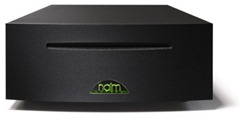 With the UnitiServe, British Naim completes their Unity system. The UnitiServe is a Windows XP Embedded based media server with a built in Red Book CD drive. The server supports a multitude of audio formats, including Flac at a resolution of up to 24bit/192KHz. The innards include parts from equally cool British lads, Digital Fidelity.
With the UnitiServe, British Naim completes their Unity system. The UnitiServe is a Windows XP Embedded based media server with a built in Red Book CD drive. The server supports a multitude of audio formats, including Flac at a resolution of up to 24bit/192KHz. The innards include parts from equally cool British lads, Digital Fidelity.
The main idea, of course, is for the UnitiServe to act as a server for multitude of NaimUniti and UnitiQute clients already casually spread across your house. It supports streaming unique content to 6 simultaneous receivers. But being a full fledged DLNA server, it will do the biddings of any compliant device on your home network.
The UnitiServe comes with 1TB of disk space or, if you so prefer, with only a 16GB SSD disk, requiring a NAS for its data.
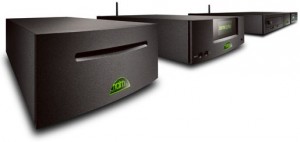
Naim UnitiQute
![]()
![]()
![]()
![]()
![]()
![]()
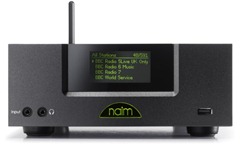 The people who gave us the NaimUnity last year have gone and done it again. This time with a cute little device aptly and cleverly named The UnitiQute. The main difference from the NaimUnity is the absence of a CD transport. In other words, the UnitiQute is for those who don’t care about perloid plastic discs or those who have a plenty of sound elsewhere and needs an extension.
The people who gave us the NaimUnity last year have gone and done it again. This time with a cute little device aptly and cleverly named The UnitiQute. The main difference from the NaimUnity is the absence of a CD transport. In other words, the UnitiQute is for those who don’t care about perloid plastic discs or those who have a plenty of sound elsewhere and needs an extension.
The front is sleek and minimalistic and very Naim. The back panel abundant with connectors for all things digital and a few analogue for good measure. The UnitiQute streams from internet radio stations and from network storage devices, be it a regular NAS or that equally sleek Naim HDX in the living room. In addition to networked music, the UnitiQute plays music from attached devices, such as iPods and USB harddrives.
Flac support of up to 24bit/96KHz puts it well in the clear with the competition. With a built-in amplifier yielding 30W of smooth niceness it is fairly self contained and should fit any small living area. Put an HDX in the study with your Focals, a Unity in the living room and a Qute in the bed room and your retirement is pretty much secured.
Lossless audio explained
My favourite company and defacto curators of good sound, Bower & Wilkins, just published an article on their Society of Sound web site, explaining lossless audio in general and Flac in particular in what can only be described as kid’s stuff. One can argue whether digital sound distribution is difficult material, but I find it indisputable that the topic is notoriously hard to convey. It is this last bit I think B&W did better than anyone before them.
If you don’t know Flac, read it to get a non-technical explanation. If you do know the technicalities, read it anyway… if for nothing else, then to get an example of how to explain it yourself.
Linn Majik DS-I
![]()
![]()
![]()
![]()
![]()
 I may be pushing the icons above a bit on this one, since Linn has not yet disclosed anything specific on their new compact. Following in the footsteps of Naim and their Uniti, Linn has gone and committed a similar product. A complete unit, albeit sans the radio and the transport. Okay, so it isn’t a complete system. It does, however, appear that the Linn Majik DS-I has everything in the realm of in- and output. Even a phono input. All you need is a tuner for the BBC must-haves, a CD transport for the not-yet-ripped CDs and a pair of speakers that can receive the angel dust from the DS and sprinkle your abode with magic.
I may be pushing the icons above a bit on this one, since Linn has not yet disclosed anything specific on their new compact. Following in the footsteps of Naim and their Uniti, Linn has gone and committed a similar product. A complete unit, albeit sans the radio and the transport. Okay, so it isn’t a complete system. It does, however, appear that the Linn Majik DS-I has everything in the realm of in- and output. Even a phono input. All you need is a tuner for the BBC must-haves, a CD transport for the not-yet-ripped CDs and a pair of speakers that can receive the angel dust from the DS and sprinkle your abode with magic.
Sonos ZonePlayer S5
![]()
![]()
![]()
![]()
![]()
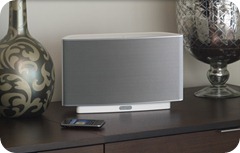 Sonos have ruled the streaming kingdom seemingly for eternities now but have been subjected to more and more frequent bashings for stubbornly sticking to less than standalone-friendly ZonePlayers. In others words: Why don’t they make a real standalone player for the kitchen (or wherever this makes sense)? Now they have… The ZonePlayer S5 is one such thing. A monolithic heat fan from appearance; a well spec’ed transistor radio beneath.
Sonos have ruled the streaming kingdom seemingly for eternities now but have been subjected to more and more frequent bashings for stubbornly sticking to less than standalone-friendly ZonePlayers. In others words: Why don’t they make a real standalone player for the kitchen (or wherever this makes sense)? Now they have… The ZonePlayer S5 is one such thing. A monolithic heat fan from appearance; a well spec’ed transistor radio beneath.
Each driven by a D-class amplifier of unknown grandeur 5 drivers form the bessel. One of these is a 3½” center positioned subwoofer [remember 3½” floppy disks? Woof!]. Otherwise it appears to be spec’ed like its brethren ZonePlayers. Like these the S5 can be controlled by the dedicated CR100 or Cr200 controllers, or from a PC or an iPhone.
RipNAS
![]()
![]()
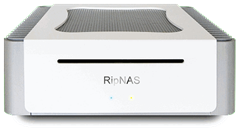 The RipNAS is not an audio streamer per this blog’s usual definition but a uPnP compatible server based on Microsoft Windows Home Server. Devices that are compatible with the uPnP standard can then connect to the RipNAS and use it for storage. What makes the device stand out is its built-in optical drive that lets you rip automatically to a number of audio formats, including Flac. Just insert a CD and rip away. The device comes preconfigured with 320GB, 640GB or 1TB harddrives and can be extended with a matching external drive to up to 7TB. That should suffice for all but the most extreme of needs.
The RipNAS is not an audio streamer per this blog’s usual definition but a uPnP compatible server based on Microsoft Windows Home Server. Devices that are compatible with the uPnP standard can then connect to the RipNAS and use it for storage. What makes the device stand out is its built-in optical drive that lets you rip automatically to a number of audio formats, including Flac. Just insert a CD and rip away. The device comes preconfigured with 320GB, 640GB or 1TB harddrives and can be extended with a matching external drive to up to 7TB. That should suffice for all but the most extreme of needs.
For streaming the device supports Logitech SqueezeCenter, Sonos , iTunes and uPnP. Also it connects automatically to such services as freedb and MusicBrainz for tagging music. Needless to say; since it is a Windows Home Server you can install just about any piece of software you can think of, such as automated backup of music or online purchases. Indeed, the server can be used simply as a Windows file server.
Copyright © 2025. Powered by WordPress & Romangie Theme.
